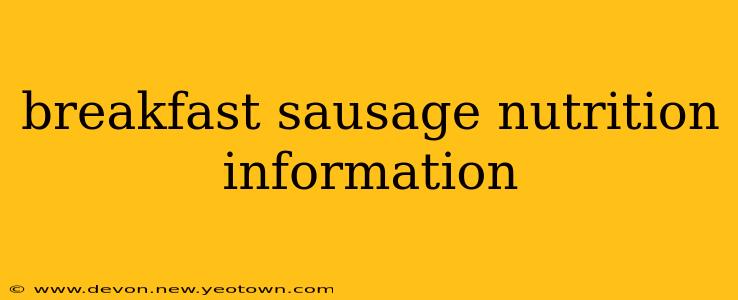Ah, the aroma of sizzling breakfast sausage – a delightful start to many mornings. But beyond the delicious taste, what's really in that link? Understanding the nutritional information of breakfast sausage is key to making informed choices about your diet. This isn't about demonizing a breakfast staple; it's about empowering you with knowledge so you can enjoy your sausage responsibly.
Let's dive into the world of breakfast sausage nutrition, unraveling the facts and tackling some frequently asked questions.
What are the common nutritional components of breakfast sausage?
Breakfast sausage, in its many forms (pork, turkey, chicken, etc.), typically contains a mix of protein, fat, and carbohydrates. The specific amounts vary wildly depending on the brand, type of meat, and added ingredients. For example, a pork sausage patty will have a drastically different nutritional profile than a turkey sausage link made with added fiber. Generally, you'll find:
- Protein: A good source, vital for building and repairing tissues.
- Fat: This contributes to the flavor and texture, but can also be high in saturated fat depending on the type of sausage.
- Sodium: Often high due to added salt for flavor and preservation.
- Carbohydrates: These are usually lower unless the sausage contains added sugars or fillers.
- Vitamins and Minerals: While not always abundant, some types of sausage may offer small amounts of vitamins like B vitamins and minerals like iron.
How many calories are in a typical serving of breakfast sausage?
This is another question with a wide range of answers! A single sausage patty or link can contain anywhere from 80 to 150 calories, or even more, depending on its size and ingredients. Always check the nutrition label on the specific product you're consuming. A larger, higher-fat sausage will naturally contain more calories.
Is breakfast sausage high in sodium?
Yes, many breakfast sausages are relatively high in sodium. This is often due to the addition of salt during processing to enhance flavor and act as a preservative. High sodium intake can contribute to high blood pressure and other health issues. If you're watching your sodium intake, consider opting for low-sodium varieties or preparing your sausage at home to control the amount of salt added.
What are the different types of breakfast sausage and how do their nutritional values compare?
The market offers a variety of breakfast sausages:
- Pork Sausage: Typically higher in fat and calories compared to other types.
- Turkey Sausage: Often a leaner alternative, with lower fat and calorie content.
- Chicken Sausage: Similar to turkey sausage in terms of leanness, but may have a slightly different flavor profile.
- Beef Sausage: Can be higher in fat depending on the cut of beef used.
- Plant-Based Sausage: These offer a vegetarian or vegan alternative with varying nutritional profiles, often lower in fat and cholesterol than meat-based sausages.
Remember to always check the nutrition label for specific details as nutritional values vary greatly between brands and products.
Are there healthier options available in breakfast sausage?
Absolutely! Making healthier choices is often as simple as reading nutrition labels and making smart selections:
- Choose leaner meats: Opt for turkey or chicken sausage over pork sausage for lower fat and calories.
- Look for low-sodium options: Minimize your sodium intake by choosing sausages specifically labeled as low-sodium.
- Read the ingredients list: Avoid sausages with excessive added sugars, fillers, or artificial ingredients.
- Consider portion size: Even healthier options can pack on the calories if you eat too much.
Can I make my own breakfast sausage to control the ingredients?
Making your own sausage at home is a fantastic way to control the ingredients and create a healthier, more flavorful product. You can experiment with different lean meats, spices, and herbs to create your perfect blend. Numerous online resources offer detailed recipes and guidance for homemade breakfast sausage.
By understanding the nutritional information of breakfast sausage and making mindful choices, you can enjoy this breakfast classic without compromising your health goals. Remember that moderation and informed decision-making are key to a balanced and healthy diet.

